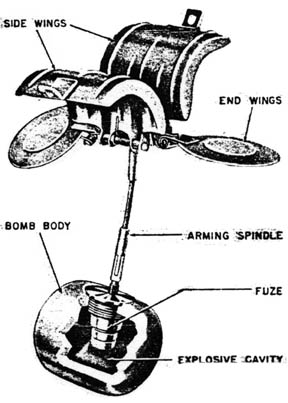Fuze
Fuze is a term that can refer to a variety of devices designed to initiate the detonation of explosive material. The primary function of a fuze is to act as a safety mechanism, ensuring that the explosive charges it is attached to detonate at the correct time or under the right conditions. Fuzes are critical components in military, industrial, and recreational explosives, playing a key role in the functionality of items ranging from simple fireworks to complex missile and bomb systems.
Types of Fuzes[edit | edit source]
Fuzes can be broadly categorized into several types based on their triggering mechanisms and intended applications. These include:
- Impact Fuzes: Also known as contact fuzes, these devices detonate an explosive charge upon direct contact with a target. They are commonly used in artillery shells and bombs.
- Time Fuzes: These fuzes are designed to detonate at a preset time after being fired or dropped. They are often used in aerial bombs and artillery shells to ensure explosions occur at specific altitudes or times.
- Proximity Fuzes: Utilizing radar, acoustic, or other sensing technologies, proximity fuzes detonate when they come within a certain distance of a target. They are particularly useful in anti-aircraft and surface-to-air missile systems.
- Electronic Fuzes: Incorporating electronic components, these fuzes offer a wide range of functionalities, including programmable timing, remote detonation, and safety locks. They are used in modern military munitions.
- Safety Fuzes: Designed to prevent accidental detonation, safety fuzes are a critical component of all explosive devices, ensuring they only explode under the correct conditions.
History[edit | edit source]
The development of fuzes has evolved alongside the history of explosives and munitions. Early fuzes were simple mechanical or chemical devices intended to delay the explosion of gunpowder long enough for the user to reach a safe distance. The introduction of more sophisticated explosives necessitated the development of more reliable and precise fuzing mechanisms. The 20th century saw significant advancements in fuze technology, particularly during the World Wars, where the need for more accurate and reliable munitions led to the invention of electronic and proximity fuzes.
Modern Applications[edit | edit source]
In the modern era, fuzes are used in a wide array of applications, from civilian to military. In the civilian sector, fuzes are used in fireworks, mining operations, and construction, where precise control over explosions is necessary for safety and efficiency. In the military, fuzes are integral to the effectiveness of artillery, bombs, and missiles, with advanced technologies allowing for highly targeted and controlled detonations.
Safety and Regulation[edit | edit source]
Given their potential for destruction, the manufacture, transportation, and use of fuzes are heavily regulated by international and national laws. Safety standards ensure that fuzes are designed and built to prevent accidental detonation, which could lead to loss of life and property. These regulations also cover the storage and disposal of fuzes, minimizing the risk of uncontrolled explosions.
Conclusion[edit | edit source]
Fuzes are a critical component of modern explosive devices, ensuring that they function as intended, whether for construction, entertainment, or defense. The ongoing development of fuze technology reflects the balance between the need for effective explosive devices and the imperative to minimize the risks associated with their use.
Search WikiMD
Ad.Tired of being Overweight? Try W8MD's NYC physician weight loss.
Semaglutide (Ozempic / Wegovy and Tirzepatide (Mounjaro / Zepbound) available. Call 718 946 5500.
Advertise on WikiMD
|
WikiMD's Wellness Encyclopedia |
| Let Food Be Thy Medicine Medicine Thy Food - Hippocrates |
Translate this page: - East Asian
中文,
日本,
한국어,
South Asian
हिन्दी,
தமிழ்,
తెలుగు,
Urdu,
ಕನ್ನಡ,
Southeast Asian
Indonesian,
Vietnamese,
Thai,
မြန်မာဘာသာ,
বাংলা
European
español,
Deutsch,
français,
Greek,
português do Brasil,
polski,
română,
русский,
Nederlands,
norsk,
svenska,
suomi,
Italian
Middle Eastern & African
عربى,
Turkish,
Persian,
Hebrew,
Afrikaans,
isiZulu,
Kiswahili,
Other
Bulgarian,
Hungarian,
Czech,
Swedish,
മലയാളം,
मराठी,
ਪੰਜਾਬੀ,
ગુજરાતી,
Portuguese,
Ukrainian
Medical Disclaimer: WikiMD is not a substitute for professional medical advice. The information on WikiMD is provided as an information resource only, may be incorrect, outdated or misleading, and is not to be used or relied on for any diagnostic or treatment purposes. Please consult your health care provider before making any healthcare decisions or for guidance about a specific medical condition. WikiMD expressly disclaims responsibility, and shall have no liability, for any damages, loss, injury, or liability whatsoever suffered as a result of your reliance on the information contained in this site. By visiting this site you agree to the foregoing terms and conditions, which may from time to time be changed or supplemented by WikiMD. If you do not agree to the foregoing terms and conditions, you should not enter or use this site. See full disclaimer.
Credits:Most images are courtesy of Wikimedia commons, and templates, categories Wikipedia, licensed under CC BY SA or similar.
Contributors: Prab R. Tumpati, MD





